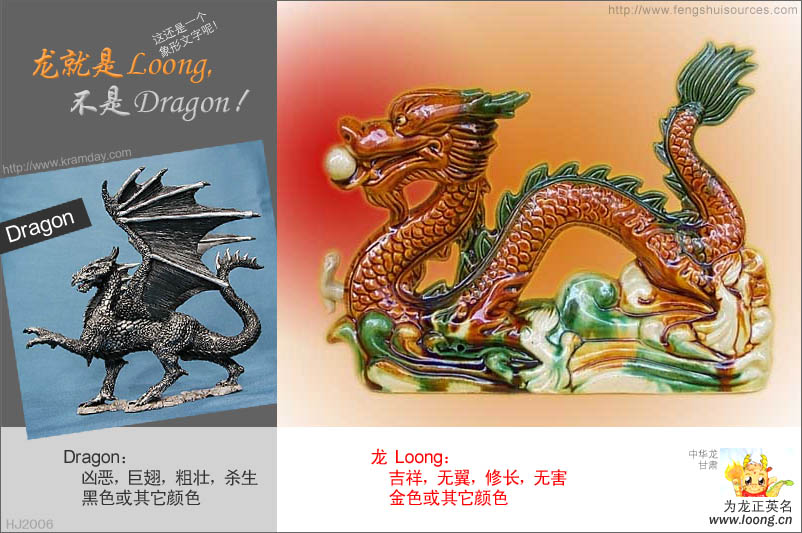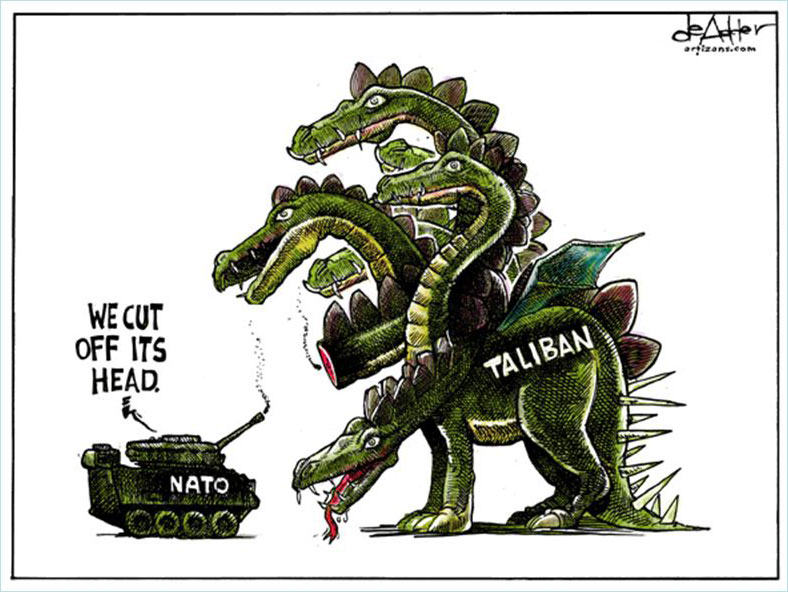

返回首页 《译龙风云——文化负载词的翻译:争议及研究》全文免费下载 |
|
美国知乎 Quora 说 Loong 和 dragon 的差别 What are the differences between the Chinese Loong and the West Dragon? https://www.quora.com/What-are-the-differences-between-the-Chinese-Loong-and-the-West-Dragon Sah Lee, Chinese, Updated Jun 17, 2015 - Nature Dragon, if I understand correctly, is usually an evil creature (more like a monster) that doesn't have intelligence or a personality. Loong is similar to some kind of god, and have their needs and thoughts. So they decide to be either good or evil, in different stories. - Appearance Dragon shows up naked. Loong is usually dressed up, human-alike, unless they are out to attack you in their battle-mode. - Gender There are male dragons and female dragons. There is just male loong. - Reproduction Dragon mates with another dragon and bears baby dragons Loong mates with all kinds of female creatures and there are various of sons of Loong. (Nine sons of the dragon) - Attacking Dragon attacks by breathing fire. Loong doesn't breathe fire. The attacking is usually done by flooding because Loong is the god of water systems. Sometimes when the situation escalates, an army of sea creatures (crabs and shrimps, etc.) could also get involved. - Flying Dragon flies with wings and respects the basics of physics. Loong doesn't have wings. They just... can fly. comments Xiao Chen, June 17, 2015 loong usually doesn't wear clothes either...unless they transform to be a human form. There are female loongs. There is a Chinese myth that a princess loong merries a human. The girl on the left is a loong who services Guanyin: Chinese gods don't fly with wings. They have the ability to make their body lighter than air. Also, they can ride on clouds. Dahoo Hurst, September 15, 2018 'Loong is usually dressed up, human-alike', I do not think so. Maybe you said King of Loong. ----------------------- Michael Chan, Lived in China, Answered Jun 10, 2015 The western dragon is essentially a fire-breathing dinosaur that can fly with ridiculously tiny wings. They are evil creatures, meant to be taken down by godly and brave knights so they have stories to tell to the next generation. Chinese dragons, on the other hand, are essentially deities! They are in charge of water bodies (rivers, lakes and seas) and bringing rain to the puny Chinese (and Korean, Vietnamese, Japanese, Thai, Laotian, etc) so that they can have great harvests and lead a good life. They fly without wings and are more snake-like than lizard-like (in Chinese mythology, snakes are cousins to dragons). ------------------ Guo Wei, writing & living in China, Answered Jan 6, 2015 Totally different animals. Chinese loongs have no wings but fly. They live in the water and will bring rain to the world. It is believed that under each of the legendary Four Seas (East, South, West and North) there lives a Loong King who is in charge of everything under that sea. Anyway, there may be a loong in every water, such as wells, rivers and lakes. People think loongs love collecting treasures. And when a loong comes along, you will see plenty of clouds with it, hiding part of its appearance. Loong is also a symbol of luck, happiness, wealth and power. As a metaphor, we compare husband and wife to Loong and Feng (phoenix). Kings and emperors are incarnations of Loong in the earthly world. And Loongs can be used as house decorations by royal families in the old time for they would protect people from anything evil. comments: Zhou Xiangyong, January 19, 2015 change foreigner's old thoughts about China's dragon JC Kira, March 3, 2015 loong is a better translation. keep it. Kerry Freeman, March 30, 2015 Correction---Lung is the correct English spelling. It is pronounced Long; but spelled Lung. ------------------------ Zoe Ruan, works at Self-Employment, Answered Jun 11, 2015 In China, loong is some kind of symbol: power, mystery, emperor blahblahblah. Actually, it doesn't really exist in life. It's a hybrid of several animals like rooster, goat, horse etc. ( In Chinese culture, we have our own zodiac, these animals are gods in zodiac.) In old days, emperors were more likely to symbolize themselves as "loong in human body." I have mentioned it's never been seen in real life, but in mythology, loong has the power to turn over everything and bless everything. It's mighty as GOD in the Bible. Emperors did that just for adding some mysterious feelings to their life. And the color of loong is always golden, this color was forbidden to be used outside emperors' palace. --------------------- Inaba Rabbit, Answered May 27, 2015 Allow me to answer in the most dragonologic way possible. A eastern Loong is seen by the people as a divine spirit and is known to be more benevolent. Its body type is greatly different from the more well known Western dragon, as it has a body not unlike that of a Wyrm. In fact, it is more closely related to the Wyrm than the dragon. Also, the Loong flies not my wings, but by levitation and traveling between spaces. Its diet have been known to compose mainly of fish and other aquatic creatures. It does not hoard treasure nor breath fire as it lacks the igniter under the tongue. A Western dragon, on the other hand is seen as devilish and evil. It is one of the rare creatures known to demontologists as treasure hoarders and a bearer of more than four limbs. It relies mainly on its large, bat-like wings for flight and possesses a flint-like organ under its tongue known as the igniter. The sole purpose of the igniter is to light the stream of methane and various other gasses produced my the dragon to create a fire-breathing effect. Its diet have been known to include cattle, game (deer, horses, foxes, etc) and the occasional human. --------------------- Johnny Bai, studied at Monash University, Answered Mar 3, 2015 Loong is a symbol of many positive things, Dragon is a symbol of a lot of negative thing. and the look is very different. Actuary they are totally different thing, the difference is even bigger than that of cats and dogs. It is very inaccurate to translate Loong into Dragon or Dragon into Loong. |

comments: Gordon Wentworth Brown, December 3, 2016 then what does Loong mean exactly? Laoji Huang, 8:57 pm Loong = Chinese Dragon ------------------- Gordon Wentworth Brown, I love dragons, Answered Dec 3, 2016 I can add nothing further other than that Loongs, often have feathers and sometimes don't look much like lizards whereas western dragons do not have feathers and almost always look like lizards. --------------------- Adrian Marco-Polo Smith, Teacher at Beijing University of Technology (2016-present), Answered Sep 29, 2017 Chinese Dragons are positive, auspicious and highly venerated. Dragons in Western Lore are synonymous with wanton death and destruction. Not necessarily an evil force, but by nature, a destructive force. |

------------------- Keith Karvelis, Answered Sep 30, 2017 A lot --------------- Croisier Chambers, knows French, Answered Jan 8, 2020 Yonsei University 2020 English essay test question Compare the dragons of the West and the East. Then apply those concepts to the contemporary society. Dragons are mythical creatures in both the Western and the Eastern civilizations. In the West, dragons symbolized evil power. In the most popular folk lore of the West, a dragon kidnaps a damsel, and a brave knight goes to defeat the dragon and to rescue the damsel in distress. This literary theme has been used in a popular coffee commercial recently. The evil nature of the dragon stems from the New Testament of the Bible. The devil is referred to as the dragon, or the old serpent. The Beast who represents the force of the Anti-Christ is referred to as the dragon. In the Eastern tradition, the dragon represents the mythical source of political authority. The emperors of China were called dragons. Their thrones were called the thrones of dragons, and their faces were referred to as the faces of dragons. There was a popular Korean TV drama series called “The Tears of the Dragon,” depicting the founding of the Yi Dynasty. In the East, dragons are not considered as evil creatures, but as divine sources of power for kings and emperors. Dragons in both traditions are mythical beings. They do not actually exist. They exist only in the myths and imaginations of mankind. The idea of a dragon may have risen from the memory of dinosaurs or their similar appearance to reptiles. Whatever the origin of the idea may have been, dragons are mythical imaginations which do not exist in reality. In that sense, dragons may refer to the non-existent source of either evil or political authority depending on who is imagining them. In the West, dragons represented the ultimate source of evil against which mankind must wrestle. As the ultimate source of evil, their existence is elusive. Though people imagine that dragons exist, they actually do not exist. Nonetheless people imagine them into existence in order to peg the identity of evil in the world. The nature of evil is elusive. We do not know where evil originates. In fact evil originates from the heart of man. It is not what goes in from outside which corrupts a man, but what comes out from within which corrupts him. But such elusive nature of evil is too abstract and vague. In order to clearly identify the source of evil, the Western man imagined the existence of the dragon as the omnipotent being against which man has to battle. In the popular culture of the late 20th century and the 21st century, however, there have been attempts to reverse the image of the dragons from negative to positive. “Puff the Magic Dragon” sung by Peter, Paul, and Mary depicted the dragon not as an evil being, but as a childish, loyal, and mischievous being which could be befriended by an innocent boy. Also recent Hollywood fantasy films depicted dragons as friendly beings coming to the aid of mankind. This attempt to reverse the image of dragons may represent the contemporary revision of the age-old religion-based concept of good versus evil principles. In the East, especially in China and Korea, dragons represented the source of political authority of the kings and emperors over the people. In the age when democracy did not exist, the mandate to govern people had to be found somewhere in order to provide legitimacy to a ruling king. In the absence of democratic elections, political legitimacy had to be invented. The use of dragons as the source of political authority must have been an effective way of creating the moral and spiritual basis of political power. As long as people look up to their kinds as dragons, they will not dare to defy the kings' authority. Both in the West and the East, the mythical dragon was imagined in order to provide some actuality to the concepts which do not concretely exist in the world. The ultimate evil does not exist as a concrete being. It is a state of being which cannot be materialized. Nonetheless the Western Christian civilization imagined the dragon into existence in order to designate the foe against which mankind must wrestle. In the East, the non-existent dragon was imagined in order to provide legitimacy to non-elected kings and emperors. In the contemporary times, we should be more realistic and responsible about where true political legitimacy comes from and where moral evil comes from. Instead of blaming moral evil on the dragon, we must own up to our own moral failure. Also instead of attributing political legitimacy to the non-existent dragon, our nations must draw their right to rule from the only source of legitimacy: the people. (黄佶编辑配图,2022年2月19日) 相关链接: “美版知乎”Quora 问答:龙和杜拉更兽有什么区别?(2018年12月18日) -------------------------- (返回顶部) |
返回首页 《译龙风云——文化负载词的翻译:争议及研究》全文免费下载 |